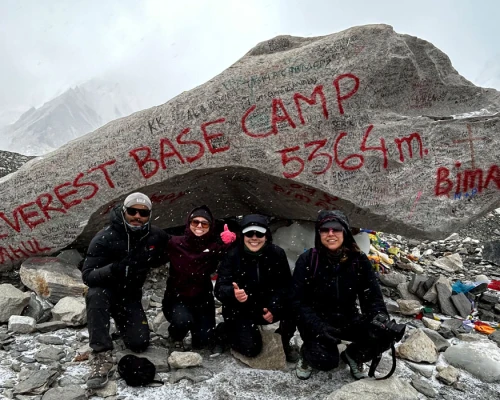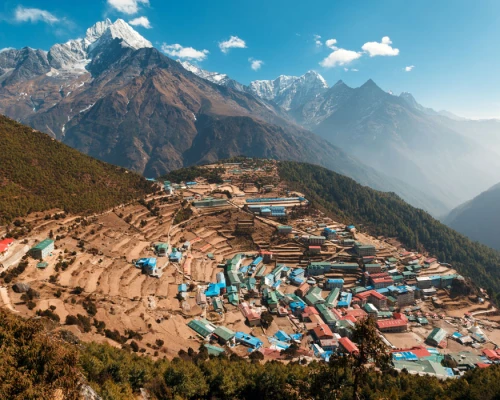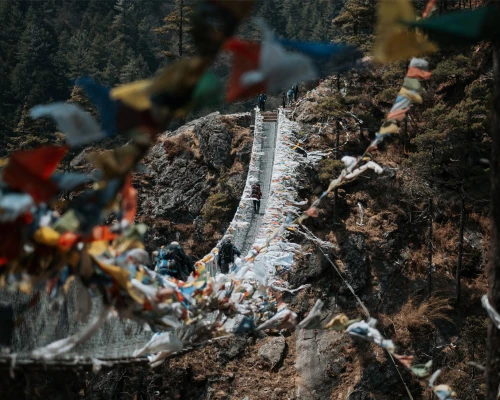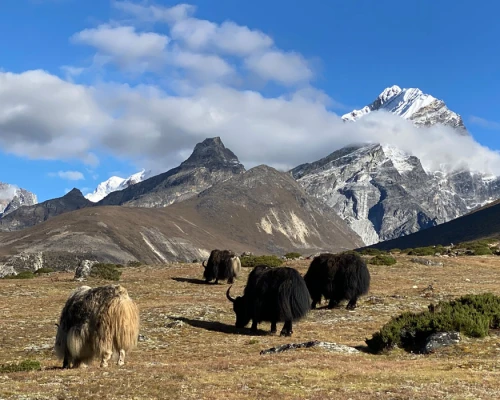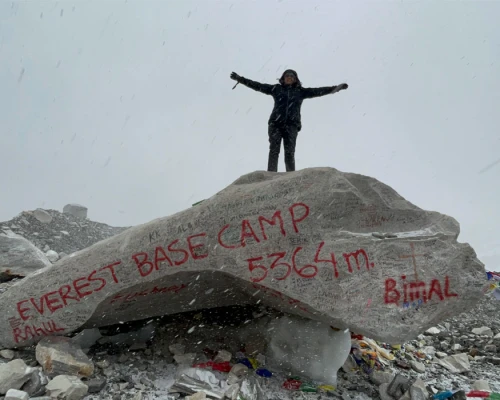The Everest Base Camp Trek with Helicopter Return is a one-way trekking trip to EBC followed by a helicopter return from Everest (Gorakshep) to Kathmandu. This trek is perfect for those who want to experience the classic Everest trail by spending less time than the actual classic trekking. This way, you can enthusiastically look forward to reaching Everest Base Camp knowing it is the highlight and also the conclusion of your trekking journey.
Highlights: Everest Base Camp Trek with Helicopter Return
- Stand tall at Everest Base Camp, the lap of the world’s highest peak.
- Rejoice in the breathtaking Everest view and surrounding scenery from Kala Patthar.
- A scenic mountain flight to the Lukla airport is a highlight in itself.
- Absorb the tranquillity of monasteries like Rongbuk, Tengboche, Dingboche, Thame, Khumjung, Pangboche, etc.
- Learn and live the authentic Sherpa culture, dance to their beats, and relish their cuisines.
- Rediscover true adventure in the rugged trails with Mani Walls and prayer flags.
- Visit the magnificent Khumbu Icefall and Glacier, the highest of its kind worldwide.
- Survey the numerous exotic plant and animal species of the Sagarmatha National Park.
- Get away with the taxing return trek with a picturesque helicopter return trip.
Trip Overview: Everest Base Camp Trek and Fly Back by Helicopter
Trekkers all over the world dream of trekking to the Everest region. Treading along beautiful Sherpa villages, relishing local Nepali cuisines, and leaving footprints at Everest Base Camp - this is a dreamy adventure. Thankfully, the Everest Base Camp Helicopter Return Trek makes the classic Everest trek experience more accessible.
The Everest Base Camp with Helicopter Return Trek lets you take a helicopter from Gorakshep right after you descend from Kala Patthar. You will get away with the latter half of the tiring trek, enjoy a scenic helicopter ride, and avoid flight delays and cancellations at the Lukla airport.
In this way, you avoid retracing the same trail on your return journey, shaving off the 65 km long return trip from the total 130 km long journey. This makes the trek a lot more pleasant and keeps the entire journey interesting. The Everest Trek with Fly Back by Helicopter is also perfect for travelers on a tight vacation schedule who still want the Everest trekking experience.
First, the trek to Everest Base Camp and Kala Patthar becomes a spectacular highlight. You’ll get enough cultural immersion into the lives of the brave Sherpa community as you trek through the Sherpa villages of Namche Bazaar, Tengboche, Dingboche, and Lobuche.
You’ll witness the rich floral and faunal diversity of the Everest region along with elaborate mountain views of Mount Everest, Lhotse, Makalu, Cho Oyu, Nuptse, Ama Dablam, Pumori, Island Peak, and more as you trudge through the Sagarmatha National Park.
After living, sleeping, eating, and exploring the heavenly Everest region like the native Sherpas during the trip, you will take an exhilarating helicopter flight back to Kathmandu from Everest Base Camp (Gorakshep). The bird’s eye view of glaciers, snow-capped peaks, and mountain valleys is a sight. Hence, the direct helicopter return trip from Everest to Kathmandu is not only a convenient arrangement but a highlight in itself.
Our Sublime Trails team carefully plans and meticulously implements the Everest Base Camp Helicopter Return Trek itinerary. Refer to the specific sections about cost, itinerary, preparation, and weather below for a quick glimpse into how we make this glorious journey possible.
Why Trek to Everest and Return via Helicopter
The Everest Base Camp (EBC) trek with a helicopter return from Base Camp to Kathmandu is getting popular for several reasons. First of all, taking a helicopter from Gorakshep back to Kathmandu significantly reduces the overall duration of the trip. While the helicopter return itinerary takes 9 days, the standard EBC trek takes 14 days to complete, including the return trek from Gorakshep to Lukla.
Instead of spending several days trekking back to Lukla and then taking a flight to Kathmandu, trekkers will return from Everest to Kathmandu in just a couple of hours. This is more convenient, and trekkers get a spare day to spend sightseeing in Kathmandu.
Second, and probably the most significant, the helicopter return takes away half the physical strain of the EBC trek. By the time trekkers reach the base camp, they are often very tired. The helicopter return helps them avoid the strenuous journey back. The standard itinerary on the other hand includes a return trek to Lukla which is hard on the knees.
Additionally, flights from Lukla to Kathmandu can be frequently delayed or canceled due to weather conditions. A helicopter provides a more reliable and flexible option.
Furthermore, the helicopter ride offers stunning aerial views of the Himalayas including Everest like in the Everest Helicopter Tour, which adds a unique and memorable experience to the trek.
Lastly, if trekkers face any health issues while at Kala Patthar or Gorakshep, especially related to altitude sickness, helicopter flyback is a quick evacuation option.
Why Does it Cost More for the Helicopter Return Trek?
The Everest Base Camp Helicopter Return Trek is costlier mainly because of the helicopter return trip. You will be shuttled from Gorakshep to Lukla, and then to Kathmandu in the helicopter.
While the plane flight from Lukla is cheaper because of the group size and commercial nature, helicopter flights are for convenience and a unique experience. Nothing beats getting a window seat and breathtaking views from a comfortable helicopter seating.
Meanwhile, in the mountain plane flight, you’ll be lucky to get a window seat, and that too, in a cramped space full of passengers. And note that mountain flights to and from Lukla are nowhere near your standard commercial flight.
While most stories you hear about the “world’s most dangerous flight” are exaggerated, do prepare to experience a bit of turbulence and limited legroom on a mountain flight.
The helicopter return, on the other hand, only seats 5 passengers at most and is roomier. Depending on your trek group size, there may even be a window seat for every passenger!
There’s also an added benefit and an additional cost metric in the EBC Helicopter Return Trek itinerary. Because we save on trip length by taking a direct helicopter flight from Gorakshep to Kathmandu, your Sublime Trails guide will also take you sightseeing in Kathmandu on the last day before you return home.
9 Days Itinerary for EBC Helicopter Trek
The 9-Day EBC Helicopter Trek starts with your arrival in Kathmandu. Our representative will pick you up at the Tribhuvan International Airport and drop you off at your hotel. With preparatory briefings and perhaps a little shopping in Thamel, you’ll be set for the mountain flight on the next day.
Flights to Lukla are operated either from Kathmandu itself or you’ll drive from Kathmandu to Ramechhap and take a flight to Lukla. Your actual trek starts from Lukla as you head off for your first night in the Everest region at Phakding.
Moving on, day 3 of your Everest Trek with Helicopter Return Itinerary concludes in Namche, and you’ll spend the next day acclimatizing in this bustling Sherpa town. You’ll then trek from Namche to Tengboche, Dingboche, and Lobuche in subsequent days.
Day 9 is the highlight of this trip when you trek to Gorakshep and then to Everest Base Camp through the Khumbu glacier. After returning and spending another splendid night in Gorakshep, you’ll hike further up to Kala Patthar, the one true viewpoint of the Everest region.
On this very day, the helicopter return option allows you to take a helicopter ride straight back to Kathmandu. You can then spend another day sightseeing the historic and culturally enriched sites in Kathmandu before you head back home after a successful trip.
Direct flight from Everest Base Camp (Gorakshep) to Kathmandu
As mentioned earlier, you will take a helicopter flight right from Gorakshep to return to Kathmandu. Gorakshep is the highest settlement in Everest, a few meters from Everest Base Camp. This eliminates the need to descend from Gorakshep to the Lukla airport for a plane flight.
Instead, the helicopter will pick you up directly from Gorakshep. Your helicopter will then fly to Lukla, make a short refueling stop, and cruise towards Kathmandu.
Because of this, there is no risk of flight delay and cancellation at Lukla.
Best Everest Trek with Helicopter Return for Everyone
The Trek to Everest Base Camp and Return by Helicopter is suitable for people from all walks of life.
First and foremost, it combines the ruggedness of an Everest Trek with the luxury, comfort, and convenience of an Everest Helicopter Tour. Hence, the EBC Trek with Helicopter Return is fitting for all people who are fans of either of them.
If you’re young and impatient, you probably do not want to return from the same trekking route after successfully reaching Base Camp. As such, the helicopter return will keep your adrenaline up while greatly enhancing the "photogenicness" of your Everest trip.
For older folks, the hardest part of any trek is the descent. While trekking up may be physically demanding, trekking down is especially taxing on the knees. With a helicopter return from Gorakshep, you will do them a favor.
All in all, this trip provides a comprehensive trekking experience from Lukla to Everest Base Camp and Kala Patthar while also allowing you to conclude your trip and return in style.




